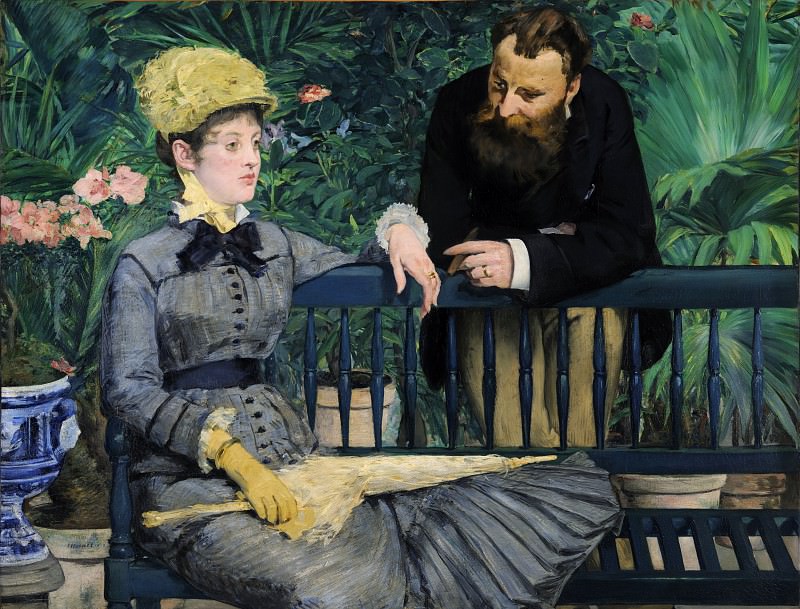In the Conservatory Édouard Manet (1832-1883)
Édouard Manet – In the Conservatory
Edit attribution
Image taken from other album: gallerix.org/s/1252869518/N/1153669273/
Download full size: 6000×4564 px (17,5 Mb)
Painter: Édouard Manet
Manet, like a true impressionist, tried to capture an event as if on the fly. Here, too, in this painting, we are confronted with a conversation between two people, a young girl and a slightly older man. The conversation, it seems, is not an easy one. You become convinced of this when you look at the girl’s face. It is haughty and capricious, she seems to have made some decision, which is clearly not to the man’s liking.
Description of Eduard Manet’s painting In the Greenhouse
Manet, like a true impressionist, tried to capture an event as if on the fly. Here, too, in this painting, we are confronted with a conversation between two people, a young girl and a slightly older man.
The conversation, it seems, is not an easy one. You become convinced of this when you look at the girl’s face. It is haughty and capricious, she seems to have made some decision, which is clearly not to the man’s liking. Most likely, there was love between them. It was fleeting, impetuous, and it burned all strength. But over time, probably short enough, the girl lost interest in the elegant man.
Maybe, and even more likely, she just wanted more, and the man wasn’t willing to spend. This is what led to the girl’s decision to break up. The fact that the girl likes chic, but not flashy clothes says her outfit. And the fact that the man is a bit stingy, but takes care of himself, his clothes also show.
The conversation between them has clearly reached an impasse, and there are simply no words to say anything. Parting is inevitable.
The canvas is simply extraordinarily informative. Not only that, one has to know Manet to understand why he placed these two in the greenhouse. It’s simple: Manet adored depicting flowers. He generally believed that of all that the Creator created - flowers - the best decoration of human life on a sinful earth.
And the artist almost on all his paintings, as well as in sketchbooks, sketched or depicted flowers. Yes, with such care that sometimes I could not believe that this is just a drawing. Here on this canvas, the couple is surrounded by a beautiful view of greenhouse flowers. Ferns and palm trees, beautifully frame the background of the unhappy conversation. At least something about this canvas is pleasing.
Manet invites us to ponder the subject and even to fantasize about what they are talking about and what they are thinking. The details are painted so vividly and clearly that it’s hard to believe.
Кому понравилось
Пожалуйста, подождите
На эту операцию может потребоваться несколько секунд.
Информация появится в новом окне,
если открытие новых окон не запрещено в настройках вашего браузера.
You need to login
Для работы с коллекциями – пожалуйста, войдите в аккаунт (open in new window).




















COMMENTS: 2 Ответы
Хорошо, что написали название: "В консерватории". Несмотря на зонтик, скамью, вазу с цветами и парочку, я ни за что не догадался бы, что сценка имеет отношение к консерватории. Может, зто оранжерея при консерватории? Тогда логичнее название: "В оранжерее (при консерватории)".
You cannot comment Why?
In In the Conservatory, Édouard Manet depicts two figures, a woman and a man, seated on a blue bench within a lush, green conservatory. The woman, formally dressed in a grey gown and a yellow hat, holds a fan in her lap and gazes pensively to the side, her expression somewhat detached. The man, in a dark coat and waistcoat, leans towards her with his arm resting on the back of the bench. His gaze is directed at the woman, and he appears to be speaking or trying to engage her.
The setting is verdant, with abundant foliage creating a dense backdrop. To the left, a decorative blue and white pot hints at the exotic plants within the conservatory. The overall atmosphere is one of quiet intimacy, yet theres a subtle tension.
The subtext of In the Conservatory is open to interpretation and has been a subject of discussion. The painting can be seen as exploring themes of:
Manets characteristic brushwork, which is visible upon closer inspection, adds to the sense of immediacy and the subjective experience of the scene, inviting the viewer to piece together the narrative and emotional undercurrents.